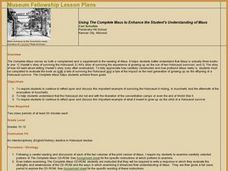Smithsonian Institution
The Soldier’s Experience—Vietnam versus World War I
The Vietnam War and World War I were two very important—and different—wars. To understand the differences, and similarities, class members watch videos, examine primary source documents, and then create a newscast that examines the...
US National Archives
The Home Front: How Did People Prepare for the War at Home?
Wars have a profound effect not only on a country's soldiers, but also on the everyday lives of its citizens. Invite young historians to discover how Britain prepared for the second World War by analyzing a series of government posters...
Curated OER
The People of World War Two
Students explore how those children returning felt isolated and how shocked they were by the changes in Britain. They explain the impact that World War Two had upon the generation born during the war. Students explore how people felt...
Curated OER
Italian Enemy Aliens During World War II: Evacuation from Prohibited Zones
Students read and discuss the Enemy Alien Evacuation Order. They perform research by reading newspaper articles from February 1942 as well as investigating available information on the Internet. Students work in groups to create a...
Curated OER
Evacuation: The Japanese Americans in World War II
Students examine Japanese internment camps of World War II. In this World War II lesson, students use primary and secondary sources to research the evacuation process and life within the internment camps. Students discuss the racial bias...
Lincoln-Sudbury Regional High School
WWII Position Paper
There are some historical events that may warrant greater reflection and more in-depth analysis, and the decision to intern Japanese-Americans in the United States during World War II, as well as to drop the atomic bomb on Hiroshima and...
Curated OER
Nothing to Fear but Fear Itself
Students investigate the years during World War II in which Japanese Americans living on the West Coast were held in internment camps.
Curated OER
Letters from the Japanese American Internment
Students explore the concept of Japanese internment. In this Japanese internment activity, students examine primary sources that enable them to discover what internment camp life was like and its implications, Students write their...
Curated OER
The Aleut Evacuation: An Overlooked Injustice
Young scholars read and complete activities about the Aleut tribe and Russian impact on the people. For this Aleut and Russian history lesson, students read a passage about the history between the Russians and the Aleut tribe. Young...
Curated OER
American Justice on Trial
Young scholars role play a trial in which they consider if the United States government violated the rights of Japanese Americans after Pearl Harbor.
Curated OER
Do Suspected Enemies Have Rights?
Students investigate the history of Japanese immigration. They complete an online Webquest, explore various websites, answer discussion questions, and locate and read newspaper articles about enemy compatants.
Curated OER
Using The Complete Maus to Enhance the Student's Understanding of Maus
Students read The Complete Maus to explore how Maus is actually three books in one. In groups, they evaluate the book as a tale of surviving the Holocaust and a tale of impacting future generations. They examine the conditions at...
Curated OER
Flawed Democracies, Human Rights
Students create drawing that tell a story about a young girl's life in an internment camp. In this internment camp lesson plan, students hear stories and analyze photographs of internment camps and then create their own drawings.












